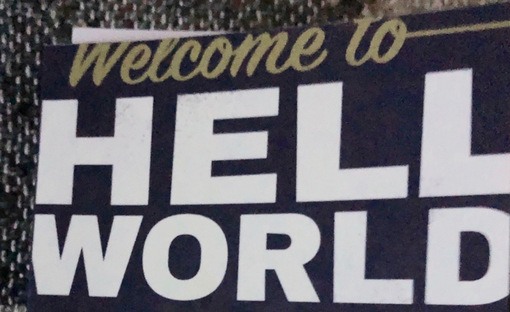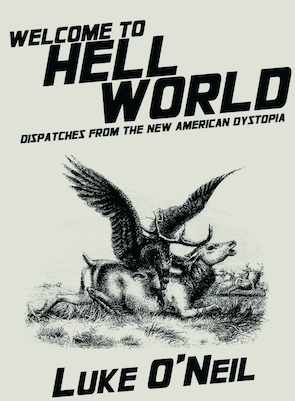
The following is adapted from Luke O’Neil’s newsletter Welcome to Hell World and his book of the same name available now, Welcome to Hell World: Dispatches from the American Dystopia.
***
There’s a girl I never want to let myself forget. Her name is Samar Hassan and we killed her family.
In January of 2005 in the northern Iraqi town of Tal Afar, Samar who was five years old at the time was riding in the backseat of her parents’ car as they returned from bringing her young brother to the hospital. It was getting dark and nearing curfew and her father likely aware of this was driving faster than normal. Fearing that the driver was a suicide bomber an army patrol in the area that evening was given permission to open fire and so they did because that is what army patrols do.
As Specialist Brad Hammond would tell it years later he and multiple other soldiers fired at least 20 rounds each into the oncoming car. When it finally came to a stop Samar and her siblings spilled out of the back with their parents now slumped over in the front seat dead from the torrent of gunfire.
“I was like, ‘Oh my god. What did we do? What did we do?” Hammond said in the film Hondros a 2017 documentary about the life of the late acclaimed conflict photographer Chris Hondros who was on hand at the shooting.
Hammond still smells what he smelled that night.
“Blood, brains. You ever smelled . . .” he says in the film inhaling deeply.Hondros was embedded with Hammond’s Apache company at the time. He quickly snapped a series of pictures of the family we destroyed including one which became one of the most searing and defining images of the war. He’d soon be banished from traveling with the company after disregarding military command’s request not to publish the photos.
Samar’s parents were but two deaths in the conservative estimate of 500,000 or more that came as a direct result of combat or its after- math in the collapse of Iraqi infrastructure and the subsequent take- over of parts of the country by the Islamic State but the photographs Hondros captured of Samar and her siblings—traumatized, bloodied, devastated—did something that reading an abstract number like that can’t ever do. It brought the dead—the distant, unknowable, easily ignorable Iraqi dead—to life.
Look at her face in the photo now. I can’t print it here but you should put this book into the trash or the toilet and go find it and stare at it for a couple hours and you’ll understand my general thesis.
Are you looking? What can she be thinking? Did she have any idea why her parents were murdered? By who?
A subsequent military inquiry determined that the attack on the car was “reasonable in intensity, duration, magnitude.”
Samar’s brother Rakan who was badly injured in the shooting as well was brought to Boston the next year for treatment for his injuries. It was aid he was afforded in no small part by the widespread attention the photos had garnered and the advocacy of an American aid worker named Marla Ruzicka. Three years later the boy was murdered in an attack by insurgents. Their uncle who was taking care of the two children at the time suspects his home was targeted specifically because the boy had traveled to the United States.
Ruzicka would also be killed in a car bombing in Baghdad not long after.
Hondros would die himself from wounds sustained in a mortar attack while covering the Libyan Civil War in 2011.
But Samar. I was trying to remember her name in September of 2018 as the weeklong destination wedding-ass funeral and round-the-clock 24/7 corpse-watch for John McCain continued its interminable slog on cable news. I worried for a while I wouldn’t be able to bring something Samar said in an interview last year back to memory. I felt guilty for having let the specificity of her anguish slip from my mind.
The documentary makers behind Hondros tracked Samar down for the film. Eighteen by then they had come to see her in part to bring her an apology from Hammond. He appears in the film himself now as a broken man unable to emotionally process the extent of what he did. Hammond still has nightmares every night he says in the film over shots of an overflowing bag of medication. Anxiety pills and so on. He still sees Rakan walking down the street when he goes to sleep.
He asked the documentarians to please tell Samar if they could find her that he is sorry.
She did not accept the apology.
“Everybody knows my story and saw my picture,” she tells the filmmakers in between the pauses as a translator relays her words leav- ing ample time for them to spread out and fill the space of the room.
“But it’s not going to help me with anything.” She remembers that night. It’s never gone from her thoughts. “I hear them screaming in my head and the sound of shooting.” “What would sorry do?” she asks. “They’re gone. Is sorry going to bring them back? No, it won’t. That’s it. It’s done.”
That weekend I saw a tweet that got 100,000 retweets in the first twenty-four hours it was posted. It was a video taken from John McCain’s funeral at the National Cathedral in which Michelle Obama can be seen taking a piece of candy from George W. Bush.
Another tweet that weekend from the New Yorker’s Susan Glaser captured the sepia-tinted nostalgia theme that abounded across social media: “Hillary Clinton and Dick Cheney next to each other at John McCain’s funeral . . . seems so much how Washington used to be, and is no longer. When America hears these stirring patriotic songs today, do they even hear the same words?”
As Glasser would later write in a piece in which she inducted Bush into the #resistance—a sentiment hundreds of Beltway lanyard-fuckers echoed on Twitter and elsewhere—McCain’s funeral was not just a beautiful tribute to a heroic man but more importantly a stirring rebuke to Donald Trump. Obama, Bush, and Meghan McCain’s eulogies were pointed shots across the bow at the nasty Trump who is the first bad president and a man whom they not-so-subtly attempted to contrast with the honorable war hero.
Needless to say the occasion of McCain’s death drove the white-collar pundit class absolutely fucking insane in all manner of ways.
“The angels were crying. Here at CNN—just a few blocks away—no rain. Just there,” CNN’s Dana Bash tweeted.
But this rehabilitation of kindly old grandpas Bush and McCain and the other architects of the Iraq War into a throwback to the good old days of politics when we all had our disagreements sure but everyone lined up and shook hands then hit the showers together after a sporting debate is a fucking bridge too far. Imagine seeing Dick Fucking Cheney anywhere outside of an iron maiden in Hell and finding something to be nostalgic about?
Here’s what Meghan McCain said about her father to resounding applause at the funeral:
“The America of John McCain is generous and welcoming and bold. She is resourceful and confident and secure. She meets her responsibilities. She speaks quietly because she is strong. America does not boast because she has no need. The America of John McCain has no need to be made great again because America was always great.”
I don’t know if any of the smooth-brained dullards in the media eulogizing John McCain—whose own theater of bravery lest we for- get led to at least a million and a half deaths including an estimated 600,000 civilians—remember much from the Bush era or just how ravenously horny for invading Iraq or any other country he thought had it coming McCain was at the time. Distance does have a way of sanding off the edges. But here’s something that came from Bush and McCain’s war I’d like more people to hear. It’s one of the last things Samar says in the documentary about the men—Bush and McCain’s men, our men—who killed her family for nothing.
What would she say to them if they were to tell her they were sorry?
“I will never forgive them. I will just leave it to God. God will pun- ish them,” she says, her voice rising in anger.
“If they were in front of me, I would want to drink their blood,” she says.
“Even then I wouldn’t be satisfied.”